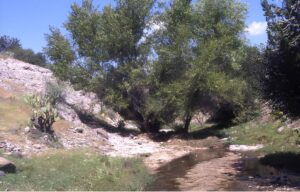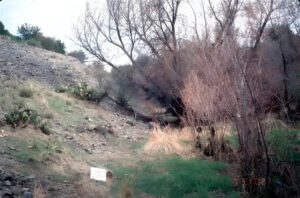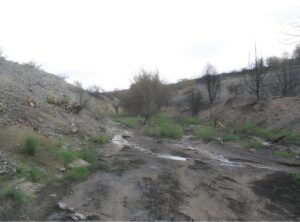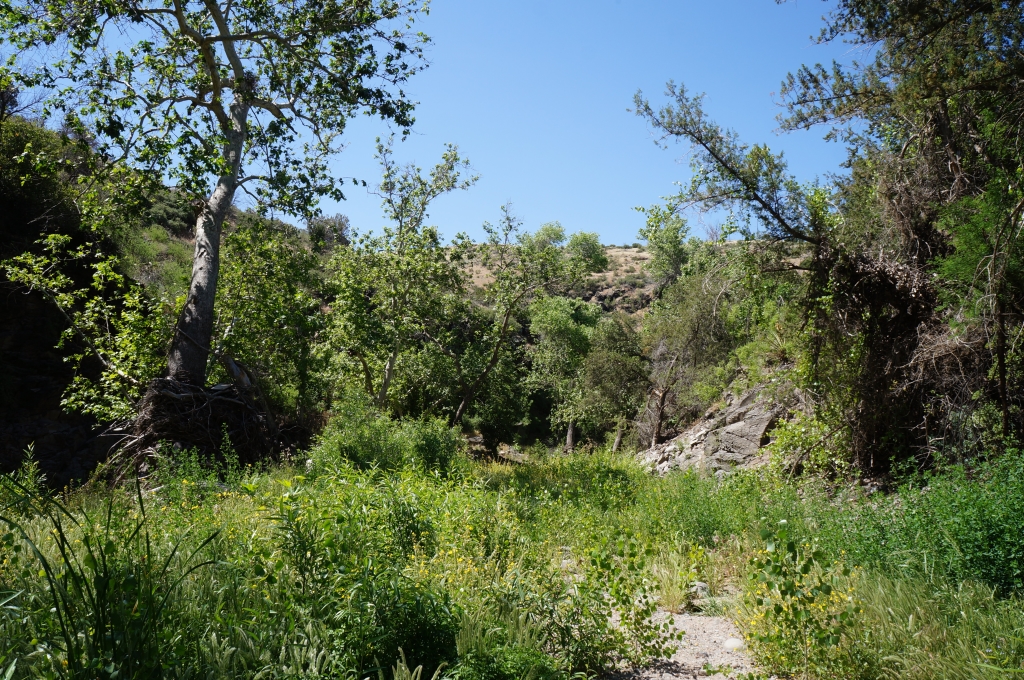Writer Joseph J. Airdo // Photography Courtesy of Friends of the Tonto National Forest



Throughout the year, volunteers armed with cameras and a passion for conservation in Arizona embark on a treasure hunt like no other. Their mission: to capture the ever-changing landscapes of the Tonto National Forest’s riparian areas and contribute to the preservation of these precious water-dependent ecosystems.
The Riparian Photopoint Program, now managed by Friends of the Tonto National Forest, traces its roots back more than 35 years.
“It all began when the U.S. Forest Service hired its first riparian specialist,” explains Patti Fenner, executive director of Friends of the Tonto National Forest. “Recognizing the value in repeat photography, this specialist initiated a small-scale program involving U.S. Forest Service personnel who would take pictures and fill out forms with a map indicating the locations of each site.”
As GPS technology was not as widely available as it is today, personnel relied on marking trees with paint or using flags to identify locations — methods that were not very permanent. Soon, a woman who initially volunteered for the U.S. Forest Service became the driving force behind the Riparian Photopoint Program.
“Her dedication led to her being hired, with her primary focus being the program’s management and recruiting additional volunteers,” Fenner recounts. “Under her leadership, the program expanded with the participation of six to eight volunteers who returned annually to revisit sites and establish new ones.”
Over the years, the program has grown, with 30–40 volunteers playing an increasingly crucial role in documenting and monitoring the health of riparian areas.
“The specialists on the forest increasingly relied on these photographs, especially when conducting environmental analyses without the opportunity to visit remote sites,” Fenner notes. “The images provided valuable insights and helped inform decisions.”
When a range watershed staff member decided to discontinue the Riparian Photopoint Program a year before Fenner’s retirement, she was motivated to establish Friends of the Tonto National Forest as a nonprofit organization with the sole purpose of supporting the U.S. Forest Service at Tonto National Forest in carrying out projects that it might otherwise be unable to due to limited funding or staffing.
“These projects range from desirable initiatives to essential tasks,” Fenner explains. “The Riparian Photopoint Program was our first undertaking because it was an essential initiative that staff wanted to preserve, despite the decision to discontinue it. Recognizing the importance of the program, we stepped in to keep it alive and made the photos publicly accessible on our website.”



Picture-Perfect Preservation
Each year, Friends of the Tonto National Forest consults with U.S. Forest Service staff to identify their priorities, as there are over 1,100 sites in Tonto National Forest — more than they could ever cover in a single year.
“By understanding their focus areas, such as monitoring the aftermath of a large fire or conducting studies in specific regions, we can prioritize those sites before visiting others,” Fenner explains.
Today, the Riparian Photopoint Program welcomes volunteers from all walks of life to participate in the unique citizen science project.
“Our participants come from diverse backgrounds and age groups,” Fenner shares. “We have retirees, young individuals and even families who join the program.”
One heartwarming example is a father-daughter duo that started when the daughter was in high school.
“Over the years, the daughter took on more responsibility, eventually leading their expeditions and submitting the photographs,” Fenner recounts. “Now, she is away at college.”
The program also boasts dedicated senior volunteers in their 80s, passionate hikers who eagerly overcome challenging terrain and share their excitement throughout the process.
“Our participants come from various professions, such as an REI employee and engineers,” Fenner adds. “Some of our volunteers are studying at semiconductor schools while devoting their free time to the program.”
To join, volunteers need only a camera or a smartphone capable of taking pictures and a willingness to explore the Tonto National Forest’s hidden gems.
“We offer a free downloadable app that provides the coordinates for all the sites and helps users identify their current location,” Fenner explains. “No formal education or experience is required to join the program. We provide all of the training needed in a 90-minute Zoom session.”
The popularity of the Riparian Photopoint Program can be attributed to the treasure hunt-like experience it offers.
“We provide participants with coordinates and a packet containing photos taken during the last visit to each site, encouraging them to match the old images with the new ones they capture,” Fenner describes. “Many volunteers appreciate the opportunity to discover hidden gems within the forest and explore beautiful riparian areas that they might have otherwise overlooked. This engaging and enjoyable activity holds great value for the forest as well.”
Beyond the photographs, the Riparian Photopoint Program encourages volunteers to share their experiences and observations through storytelling.
“Incorporating the narrative aspect has been a valuable addition to our program,” Fenner emphasizes. “During training, I like to share the secrets of certain photo points, emphasizing the importance of storytelling in capturing the essence of each location.”
Volunteers are encouraged to take detailed notes, creating a more engaging and friendly experience for future participants. These stories, ranging from encounters with rare wildlife to observations of unauthorized activities, add depth to the program and foster a sense of community among volunteers.
“We have found that this approach adds depth to our initiative and makes it more appealing to those who join,” Fenner shares. “This is why we have started asking for more notes from our volunteers rather than solely relying on the photos themselves.”



Framing the Future
The Riparian Photopoint Program’s significance extends beyond the Tonto National Forest, as it plays a crucial role in protecting one of Arizona’s most precious resources: water.
“Riparian areas are fundamentally about water, which is undeniably one of the most critical resources in Arizona,” Fenner stresses. “Encouraging people to actively engage in the forest’s activities fosters an understanding of the importance of these areas and what can be done to preserve them.”
By documenting changes in riparian areas over time, the program helps inform land management decisions and raises public awareness about the need for conservation.
“Our primary point of contact in the forest is the forest hydrologist,” Fenner explains. “She collects the previous and current photos for each site and conducts a brief analysis annually to identify potential issues such as overgrazing, which can be apparent in the photographs.”
The photographs can also help detect the presence of invasive plants like fountain grass, which commonly encroaches on riparian areas.
“Through this analysis, the forest hydrologist aims to determine the factors that land managers can influence to maintain the health of the riparian ecosystem,” Fenner adds.
As the Riparian Photopoint Program continues to thrive under the guidance of Friends of the Tonto National Forest, it serves as a powerful reminder of the importance of citizen science in protecting Arizona’s precious natural resources. By engaging volunteers in the documentation and monitoring of riparian areas, the program not only collects valuable data but also cultivates a deep appreciation for these vital ecosystems.
“Some of our longtime volunteers have adopted specific sites and make annual visits, allowing them to develop a deeper understanding of the changes occurring in these locations,” Fenner shares. “By nurturing this connection, volunteers are more likely to notice important details and advocate for necessary improvements.”
Through the lens of a camera and the power of storytelling, the Riparian Photopoint Program invites Arizonans to become active participants in the conservation of their state’s natural wonders, ensuring that these riparian treasures will endure for generations to come.
“By engaging people in this way, we hope to cultivate a sense of involvement and ownership in the forest’s conservation,” Fenner concludes. “Encouraging visitors to actively observe, reflect on and report their findings ensures they feel invested in the forest’s future.”







Comments by Admin